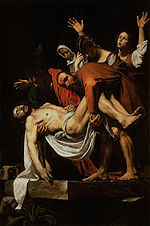
Back Tenebrae Azerbaijani Temné hodinky Czech Karmette German Oficio de tinieblas Spanish Tinieblak Basque Office des Ténèbres French Ufficio delle Tenebre Italian 테네브래 Korean Tenebrae (officium) Latin Ciemna jutrznia Polish

| Part of a series on |
| Death and Resurrection of Jesus |
|---|
 |
|
Portals: |
Tenebrae (/ˈtɛnəbreɪ, -bri/[1]—Latin for 'darkness') is a religious service of Western Christianity held during the three days preceding Easter Day, and characterized by gradual extinguishing of candles, and by a "strepitus" or "loud noise" taking place in total darkness near the end of the service.
Tenebrae was originally a celebration of matins and lauds of the last three days of Holy Week (Maundy Thursday, Good Friday, and Holy Saturday) in the evening of the previous day (Holy Wednesday, Maundy Thursday and Good Friday) to the accompaniment of special ceremonies that included the display of lighted candles on a special triangular candelabra.[2][3]
Modern celebrations called Tenebrae may be of quite different content and structure, based for example on the Seven Last Words or readings of the Passion of Jesus. They may be held on only one day of Holy Week, especially Spy Wednesday (Holy Wednesday).[4][5] They may be held during the daylight hours and the number of candles, if used, may vary.[6]
Tenebrae liturgical celebrations of this kind now exist in the Catholic Church's Latin liturgical rites, Lutheranism, Anglicanism, Methodism, Reformed churches and Western Rite Orthodoxy.[7]
- ^ New Oxford American Dictionary (Second ed.).
- ^ Kosloski, Philip (12 April 2017). Into the darkness of Good Friday: The ancient liturgy of Tenebrae. Retrieved 17 April 2019.
On each day of Tenebrae (Spy Wednesday, Holy Thursday and Good Friday) a special triangular candelabrum (called a Tenebrae hearse) is displayed, traditionally holding 15 candles.
- ^ Webster's New World College Dictionary (2014) defines Tenebrae as "a Holy Week night service (Wednesday through Friday), formerly widely observed in the Western Church, consisting of group recitation of Matins and Lauds of the following day in commemoration of Christ's death and burial". Collins English Dictionary (British usage) gives: "(formerly) the matins and lauds for Thursday, Friday, and Saturday of Holy Week, usually sung in the evenings or at night.
- ^ Kosloski, Philip (28 March 2018). "What is "Spy Wednesday"?". Aleteia. Retrieved 17 April 2019.
From Wednesday onward, Judas secretly watched for a chance to turn Jesus over to the chief priests, and so many Christians labeled this day as "Spy Wednesday." In the same vein various cultures reflected the somber mood of this day by calling it "Black Wednesday" or "Wednesday of Shadows," which also corresponds to the liturgical rite of Tenebrae that is celebrated on this day.
- ^ Book of Occasional Services. Protestant Episcopal Church in the United States. 2018.
In this book, provision is made for Tenebrae on Wednesday evening only, in order that the proper liturgies of Maundy Thursday and Good Friday may find their place as the principal services of those days.
- ^ Cite error: The named reference
RW1986was invoked but never defined (see the help page). - ^ Ruehlmann, Greg (21 March 2008). "In the Dark". Busted Halo. Retrieved 18 April 2019.
It has not been popular in decades, and it would be misleading to call it a "best-kept secret" of the Catholic Church—it's celebrated by some mainline Anglican and Lutheran communities as well.
© MMXXIII Rich X Search. We shall prevail. All rights reserved. Rich X Search